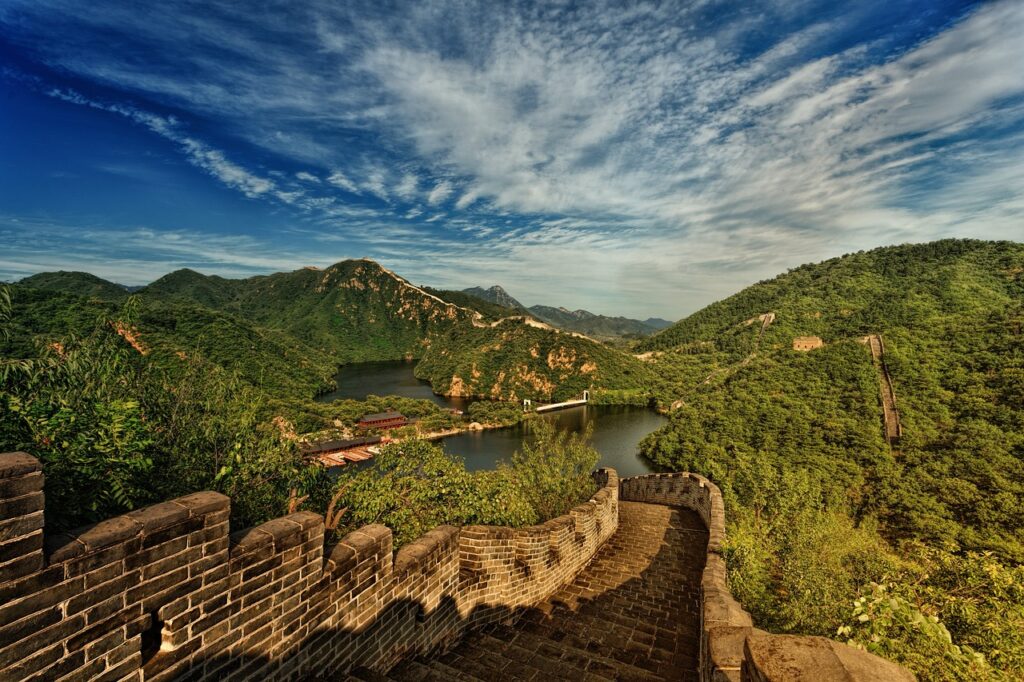The Great Wall of China traces its origins back to the fifth century B.C. during the Warring States Period, when fragmented kingdoms constructed their own walls for defense against invasions, showcasing both architectural prowess and the need for security in a turbulent time. It was not until 220 B.C. that the vision of a unified wall emerged, championed by Qin Shi Huang, the first emperor of a consolidated China, who commanded the integration of various walls along the northern frontier, necessitating a colossal building effort to create a cohesive defense system known as the ‘Wan Li Chang Cheng,’ or the 10,000-Li-Long Wall, spanning over 3,000 miles.
Construction and Labor
Directed by the renowned general Meng Tian, the construction process involved a vast workforce composed of soldiers, criminals, and commoners. The wall, primarily made of earth and stone, was fortified with guard towers and ramparts reaching heights of up to 30 feet. This engineering feat embodied the might and ambition of a nation striving for unity and stability in the face of external dangers.
Development Through Dynasties
After the fall of the Qin Dynasty, much of the Great Wall fell into disrepair. Subsequent dynasties, particularly the Northern Wei and the Sui, recognized its defensive value and extended or repaired sections of the wall to counter threats from rival tribes. However, it was during the Ming Dynasty (1368–1644) that the wall experienced significant renovations and expansions. The Ming rulers, facing the rising threat from the Mongols, undertook extensive construction efforts that defined the Great Wall in its current form.

Ming Dynasty Renovations
The Ming Great Wall, stretching from the Yalu River in Liaoning Province to Gansu Province, showcased a clear separation of inner and outer walls, each fortified with strategic passes and gates. This period’s construction was marked by meticulous planning and execution, with each section designed to respond effectively to military needs and the geographical landscape. It was during this time that the wall solidified its place not only as a military fortification but also as a symbol of national pride.
Strategic Importance Over Centuries
The Great Wall’s strategic importance fluctuated over the centuries. While it served as a formidable barrier against invasions, its role evolved alongside the political landscape. During the Tang Dynasty, the wall lost its significance as a defense structure as the empire expanded past its borders. The Yuan Dynasty employed it more as a means to protect merchants and trade routes, notably the Silk Road. The Ming Dynasty’s renewed emphasis on the wall as a defensive bulwark reflected the dynamic interplay between architecture, military strategy, and governance.
Cultural and Historical Impact
The impact of the Great Wall extends beyond its physicality; it symbolizes the profound cultural exchange and conflicts between agricultural and nomadic civilizations. It stands as a representative of China’s efforts to protect itself from external influences while showcasing national identity. The wall embodies historical narratives of suffering, sacrifice, and resilience, influencing Chinese literature and folklore throughout the centuries. Notably, estimates suggest that as many as 400,000 workers perished during the building process, many of whom were interred within its walls, becoming part of its storied legacy.

Modern Recognition and Preservation
During the seventeenth century, the Manchus breached the Great Wall, leading to the fall of the Ming Dynasty and the rise of the Qing Dynasty, marking a significant transformation for both the Wall and Chinese society. Despite this, the Great Wall emerged as the quintessential symbol of China for the Western world in the ensuing centuries, representing both physical strength and a psychological barrier against foreign encroachment.
UNESCO’s designation of the Great Wall as a World Heritage Site in 1987 has further solidified its status as a global cultural treasure. Today, it is celebrated as one of humanity’s most impressive architectural feats, drawing millions of visitors worldwide who come to marvel at its scale and history. However, this also poses challenges; parts of the wall have suffered from neglect and modern encroachments, requiring ongoing conservation efforts to preserve its integrity.
Architectural and Cultural Significance
The Great Wall’s diverse construction styles evolved over centuries, with each dynasty contributing unique features reflecting the era’s technological advancements and aesthetic sensibilities. The use of local materials, such as stone in northern regions and earth and wood in southern areas, showcases the ancient Chinese wisdom of harmonizing human creation with the natural environment.
The wall also serves as a canvas for artistic expression. Poets, painters, and artisans have drawn inspiration from its grandeur, capturing its essence in ink wash paintings and poignant verses. This artistic interpretation transforms the Wall from a mere structure into a symbol of resilience and endurance.
The Great Wall’s Modern Challenges
The Great Wall’s role as a cultural identity marker extends beyond borders, captivating the imagination of people worldwide and promoting cultural exchange and understanding. However, the influx of tourists has placed considerable strain on certain sections, leading to deterioration and erosion. Balancing public access with conservation efforts is a pressing concern for authorities.
Heritage Preservation and Sustainability
The significance of the Great Wall extends to modern discussions about heritage preservation and sustainability. As nations grapple with safeguarding their historical sites amidst rapid development, the Great Wall stands as a model of resilience and adaptability. Efforts to integrate sustainable tourism practices, such as limiting visitor numbers and promoting responsible behaviors, are crucial steps toward ensuring that the Wall continues to inspire awe and reverence for years to come.
The Great Wall of China epitomizes the cultural, architectural, and historical narratives that have shaped China and its people. From its origins as a military fortification to its current status as a symbol of national pride, the Wall tells a story of human endeavor and ingenuity. As we walk the ancient stones and gaze at the sweeping vistas, we are reminded of the wisdom of our ancestors who built this monumental structure. The Great Wall invites us to reflect on the lessons of history, inspiring us to build a future grounded in unity, understanding, and respect for our shared heritage. In appreciating the Great Wall, we celebrate the enduring legacy of human creativity and the powerful stories that connect us all across time and space.
Related posts:
Great Wall of China ‑ Length, Map & Facts
The Great Wall of China Is Under Siege





